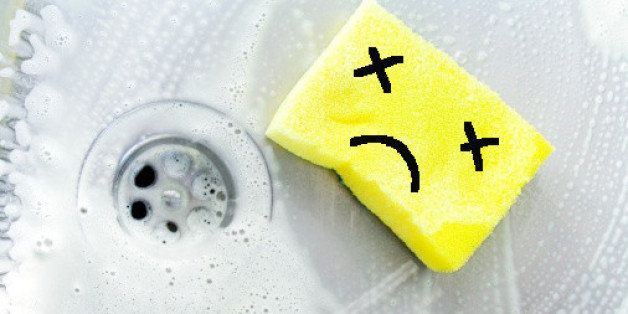
The kitchen sponge is the single dirtiest item in your house. Yes, it's nastier than the toilet seat, the garbage can and the diaper genie.
"It has a lot of nooks and crannies, so as you clean up a mess with potential pathogens in it, some of the organisms become lodged in between the sponge," Dr. Philip Tierno, a clinical professor at the Microbiology and Pathology departments at NYU Langone, and author of, The Secret Life of Germs told HuffPost. "People rinse their sponges, but they really need to sanitize them. And that's something people don't do."
When you wipe food remnants from your dirty dishes, cutting board and countertop, any pathogens from your spills can fill the holes of the damp sponge, which sits sink-side. While the sponge hangs out wet and stagnant until next use, new bacteria grows at the surprising rate of once every 20 minutes, according to Tierno.
The cutting board is particularly notorious: After you've cut up a piece of raw meat, it's common to wipe off whatever blood and other liquid has collected there -- often ground zero for one of the most common food-poisoning bacteria: salmonella. But that doesn't let vegetarians and vegans off the hook.
"Even vegetable matter may contain these germs," Tierno said. The veggies could be contaminated with E.coli, some strains of which cause diarrhea. E. coli infections are also often the cause of urinary tract infections and pneumonia.
If you're using a sponge to clean off a dish, and then consider that dish "clean," well, it's actually probably dirtier than it was before you scrubbed. "Soap and water don't kill germs -- they only wash germs away. But if you have a dirty sponge to start with, you have a nice layer of germs to cover your plate." So basically, the germs on the plate might dissipate, but the more robust germs on the sponge will transfer to the plate. Yikes.
As for that notorious sponge smell? "Where there is odor, there are germs," said Tierno.
But fear not, there is hope for a more hygienic kitchen without abandoning the sponge as a cleaning tool. The best sanitizing agent is chlorine bleach. Make a disinfecting solution by mixing one part bleach with nine parts water and drop the sponge in the mixture from 10 to 30 seconds (or longer). "This will kill all of the organisms growing in the sponge," Tierno said.
He suggests keeping a container of the solution for easy access any time you use the sponge, you can clean it with the mixture (but don't reuse the mixture). After the sponge is soaked, wring it out and allow it to dry: "Dryness itself is like a preservative -- it prevents anything from growing." But, Tierno warns, dryness alone will not kill organisms -- the sponge must be disinfected first.
You can also microwave the sponge to disinfect it, but this method isn't as simple as plopping it in and hitting "start." Tierno says the sponge should be submerged in a bowl of water and then placed in the microwave. The water has to be heated to a boil -- it will permeate the sponge and kill of the organisms. This sanitizing strategy will take longer than the bleach-water method, because you have to watch to make sure the water bubbles. Again, after the sponge is saturated, allow it to dry.
Once you've properly cleaned your sponge, be sure to wash your hands. After all that scrubbing and cleaning, you've touched a lot of the organisms that make your sponge germy in the first place.